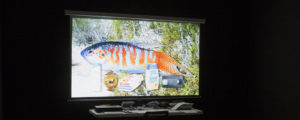art berlin contemporary (abc), running during Berlin Art Week, from September 13 to 18, is presented as a hybrid between a curated salon-like exhibition and a commercial platform, gathering a carefully selected set of international galleries, including Kraupa-Tuskany Zeidler, PSM and Societé, among others. The event depicts itself as more than just an art fair, focusing on a smaller number of artists with single propositions.
The way art is usually consumed nowadays in biennials and fairs resembles a conceptual binge: a compulsive, unachievable mental record of one thing after another, with a viewer forced to accept the impossibility of achieving an overall view in detail. In the case of abc, however, its 62 participating galleries seem to constitute a feasible amount of displays to see, distributed in only one hall, Station Berlin near the German capital’s Gleisdreieck Train Station.

In this 2016 edition, a much smaller and humbler setup than previous years, is presented at the usual location: a 19th century brick station and former Dresdener Bahnhof devoted to imports and postage in the 20th century and now host to miscellaneous events. Although spacious, the building feels rather non-excessive, as only half of the building is taken up by the fair, in contrast to previous editions of abc.
The single focus on one artist and the reduced space afforded to each gallery makes for an unusually comfortable and placid experience, in relation to the more common anxiety of art fairs. The resulting — in the words of abc’s organisers — “rigorous selection” of galleries feels slightly insufficient, given the diminished amount of exhibitions on display and without a decrease in entry price.
The visual dimension of a social body mediated by infrastructures of control is suggested, for instance, by Alona Rodeh’s twenty-one paintings from her recent exhibition at Grimmuseum where the Israeli artist explores the aesthetic potential of security and surveillance, bringing together reflectant materials for colors and infrastructural material, like aluminium. In ‘Safe and Sound, (High Visibility)’ (2016), the official turns trendy and the useful prop turns autonomous artwork out of Rodeh’s collection of hi-vis workwear.

At gallery Guido W. Baudach’s booth, shared with Vilma Gold, digital media pioneer Markus Selg presents ‘Subliminal Fire/Present Ancestors’ (2016): a staged giant rag doll lifting its worshiping arms. Sitting on a domestic blanket, positioned as looking to a vertical screen, it is reminiscent of Nam June Paik’s ‘TV-Buddha’ (1974), melting esotericism and a popular fascination with mass-media technologies.
At Carlier/Gebauer’s booth, Laure Prouvost’s installation consists of two narrow corridors hidden behind a wall-scale piece of painted fabric that leads to two humourous video works. Shown on two old TV monitors on plinths, there is one in each corridor. The first depicts a close up of the artist’s torso and hands, while her voice narrates the unacknowledged discovery of a sign of God materialised in a set of vegetables the artist envisions when waking up. Throughout the film she explains why those vegetables are a sign of God and how no one takes this fact seriously, not even the artist’s grandfather. The other monitor depicts two hands smearing hand-soap through the pages and the cover of a book about conceptual artist and developer of time-related theories, John Latham. Perhaps it satirises the traditional figure of the male genius, sliding female fingers softly, distributing this substance, which on the screen appears critically similar to sperm. The two video installations are surrounded by each film’s protagonist: the actual props, like the vegetables and the soap container, serving as three-dimensional still lifes as well as a symbol of the absurdity of the acts.

On another corner, next to the fair’s café-restaurant, a colorful and flashy van turns out to be Kenny Scharf’s ‘Closet #16’. It’s the sixteenth version of an eponymous project, which began in the ‘80s when the painter, sculptor and performer was sharing a studio with graffiti artist Keith Haring. Collecting trash and decorating compact spaces with it as an escapist and therapeutic process, Scharf’s hobby became a ritual and the ritual became the project called Closet. This most recent iteration is a permanent and portable container of diverse found objects, such as toys, electronics and detergent boxes, painted with neon colors and acting as a surface to reflect the low lights, randomly directed by a disco ball. All of this is accompanied by lo-fi mambo music played by an old cassette player painted in the same fashion as the rest of the fluoro piece in the space.
Author of the NET manifesto and iconic figure within conceptual movements, Polish artist Jarosław Kozłowski’s framed newspaper pages, painted with one monochromatic layer, are hung on Profile Foundation booth’s walls, accompanied by some paper bags containing monochrome painted paper on the ground. A low table lies a book about Kozłowski’s NET proposition, which represents a non-institutional exchange of ideas –in his words. Those concepts, such as non-commerciality, unauthored nature and the capacity of being copied and reproduced, heavily contrast with the traditional spirit of an art fair.
Yet, it’s this paradoxical contextualisation of a work that reflects the contradictory nature of abc itself. While still trying to find the most effective way to present this hybrid model, abc represents a skeletal framework hopefully acting as raw material to be exploited and developed; a new way of marrying commerciality with conceptual and curatorial practices.**















